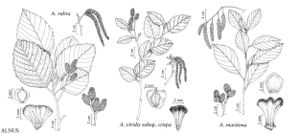Alnus viridis subsp. crispa
Bot. Mag. 173: 382. 1962.
Shrubs, spreading or rather compact, to 3 (–4) m. Bark grayish brown; lenticels pale. Leaf-blade dark green, broadly to narrowly ovate or elliptic, 3.5–6 (–10) × 3–5 (–7) cm, leathery, base rounded, obtuse, or cuneate, sometimes nearly cordate, margins serrulate or finely serrate, apex obtuse to acute; surfaces abaxially glabrous to velutinous or occasionally tomentose, moderately to heavily resin-coated. Inflorescences: staminate catkins 2.5–9 cm. Infructescences 1.2–2 × 0.5–1.2 cm; peduncles 1–5 cm. 2n = 28.
Phenology: Flowering spring.
Habitat: Singly or in thickets along streams, lakeshores, coasts, and bog or muskeg margins, or on sandy or gravelly slopes or flats
Elevation: 0–2000 m
Distribution

St. Pierre and Miquelon, Greenland, Alta., Man., N.B., Nfld. and Labr. (Nfld.), N.W.T., N.S., Ont., P.E.I., Que., Sask., Maine, Mass., Mich., Minn., N.H., N.Y., N.C., Pa., Tenn., Vt., Wis.
Discussion
Alnus viridis subsp. crispa grows across much of the continent in the far North; widely disjunct populations occur in the Appalachians in Pennsylvania and on the summit of Roan Mountain on the North Carolina–Tennessee border (R. B. Clarkson 1960; E. T. Wherry 1960).
The Cree used Alnus viridis subsp. crispa medicinally for the astringent qualities of the bark and to treat dropsy (D. E. Moerman 1986).
Selected References
None.
Lower Taxa
"thin" is not a number.
